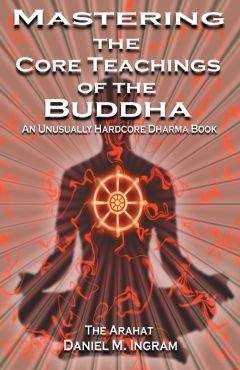Daniel Ingram - Mastering the Core Teachings of Buddha - An Unusually Hardcore Dharma Book
На сайте mybooks.club вы можете бесплатно читать книги онлайн без регистрации, включая Daniel Ingram - Mastering the Core Teachings of Buddha - An Unusually Hardcore Dharma Book. Жанр: Прочее издательство -,. Доступна полная версия книги с кратким содержанием для предварительного ознакомления, аннотацией (предисловием), рецензиями от других читателей и их экспертным мнением.
Кроме того, на сайте mybooks.club вы найдете множество новинок, которые стоит прочитать.

Daniel Ingram - Mastering the Core Teachings of Buddha - An Unusually Hardcore Dharma Book краткое содержание
Mastering the Core Teachings of Buddha - An Unusually Hardcore Dharma Book читать онлайн бесплатно
There is also a strong tradition in the West of believing that enlightenment involves perfecting ourselves in some psychological sense, though this is also prominent in certain Eastern and traditional models as well in slightly different forms.
Just about all of these sources contain some aspects that may at times be useful and other aspects that at times may be useless or even send people in the wrong direction. The number of contradictions that can be found even within each specific tradition on the subject is much larger than I think most people imagine. For instance, those who attempt a systematic review of the dogmas of enlightenment within the Pali Canon will find themselves tangled in a mass of widely divergent doctrines, myths, stories and ideals, and this is only one tradition.
Thus, to take on the subject of the models of the stages of
enlightenment is a daunting task, but by breaking it down into simplified categories, some discussion of this wide mass of dogma and half-truth is possible. I will use both simple, broadly applicable models and also discuss specific models that come from some of the traditions and try to relate these to reality. In the end, relating them to reality is essentially the practice, and that falls to you.
I consider this attempt to be just one addition to an old tradition that attempts to reform the dogma and bring it back in line with verifiable truths, albeit one that is more specific and comprehensive than any that I have found. Each new culture, place, time and situation seems to need to do this again and again, as the forces within us and society that work to promote models that are out of touch with the truth of things are powerful and perennial, with money, power, fame, ideals of endless bliss and pleasure, the enticing power of the ideals of self-perfection and the pernicious inertia of tradition being chief among them.
In that same vein, this chapter is very much a situation in which I claim a very high level of realization, write as if what I have achieved is 264
Models of the Stages of Enlightenment sufficient authority to write a chapter such as this one, and then present it as if this is a definitive text on the subject, sufficient to contradict significant portions of 2,500 years of tradition and the teachings and writings of countless previous and current commentators. While it is hard from my current vantage point to not believe this to be true, anyone with sense will read this chapter with appropriate skepticism, and this, as I see it, is one of the strengths of properly applied Buddhism and rational thought in general. The Buddha was forever asking people to not take his word at face value, but instead to do the experiment and see if they come to the same conclusions. I recommend the same. If you are able to achieve something beyond what I state is possible, more power to you, and please let me know how you did it! I would feel real regret if I thought that this work had hindered anyone from achieving their full human potential, and am always looking for practices and concepts that are useful.
Here is a list of the basic categories of models that I use, though most traditions contain a mix of most or all of these. There are probably other aspects of the dreams of enlightenment that I have failed to address, but this list should cover most of the basic ones. I look at each of these as representing some axis of development, and basically all of them are good axes to work on regardless of what they have to do with enlightenment. That said, from what I have already written, it will not be hard to pick out my favorites:
1. Non-Duality Models: those models having to do with eliminating or seeing through the sense that there is a fundamentally separate or continuous center-point, agent, watcher, doer, perceiver, subject, observer or similar entity.
2. Fundamental Perceptual Models: those that have to do with directly perceiving fundamental aspects of things as they are, including perceiving emptiness, luminosity, impermanence, suffering, and other essential aspects of sensations regardless of what those sensations are.
3. Specific Perceptual Models: those that involve being able to perceive more and more, or all, of the specific sensations that make up experience with greater and greater clarity at most or all times, and usually involve perfected, continuous, panoramic mindfulness or concentration at extremely high speed.
265
Models of the Stages of Enlightenment
4. Emotional Models: those that have to do with perfecting or limiting the emotional range, usually involving eliminating things like desire, greed, hatred, confusion, delusion, and the like.
5. Action Models: those that have to do with perfecting or limiting the things we can and can’t do in the ordinary sense, usually relating to always following some specific code of morality or performing altruistic actions, or that everything we say or do will be the exactly right thing to have done in that situation.
6. Powers Models: those that have to do with gaining in abilities, either ordinary or extraordinary (psychic powers).
7. Energetic Models: those that have to do with having all the energy (Chi, Qi, Prana, etc.) flowing through all the energy channels in the proper way, all the Chakras spinning in the proper direction, perfecting our aura, etc.
8. Specific Knowledge Models: those that have to do with gaining conceptual knowledge of facts and details about the specifics of reality, as contrasted with the models that deal with perceiving fundamental aspects of reality.
9. Psychological Models: those that have to do with becoming psychologically perfected or eliminating psychological issues and problems, i.e. having no “stuff” do deal with, no neuroses, no mental illnesses, perfect personalities, etc.
10. Thought Models: those that have to do with either limiting what thoughts can be thought, enhancing what thoughts can be thought, or involve stopping the process of thinking entirely.
11. God Models: those that involve perceiving or becoming one with God, or even becoming a God yourself.
12. Physical Models: those that involve having or acquiring a perfected, hyper-healthy or excellent physical body, such as having long earlobes, beautiful eyes, a yoga-butt, or super-fast fists of steel.
13. Radiance Models: those that involve having a presence that is remarkable in some way, such as being charismatic or radiating love, wisdom or even light.
14. Karma Models: those that involve being free of the laws of reality or causes that make bad things to happen to people, and thus living a blessed, protected, lucky, or disaster and illness-free life.
266
Models of the Stages of Enlightenment 15. Perpetual Bliss Models: those models that say that enlightenment involves a continuous state of happiness, bliss or joy, the corollary of this being a state that is perpetually free from suffering. Related to this are models that involve a perpetual state of jhanic or meditative absorption.
16. Immortality Models: those that involve living forever, usually in an amazing place (Heaven, Nirvana, Pure Land, etc.) or in an enhanced state of ability (Angels, Bodhisattvas, Sorcerers, etc.).
17. Transcendence Models: those models that state that one will be free from or somehow above the travails of the world while yet being in the world, and thus live in a state of transcendence.
18. Extinction Models: those that involve getting off of the Wheel of Suffering, the round of rebirths, etc. and thus never being reborn again or even ceasing to be at the moment of enlightenment, that is, the great
“Poof!” on the cushion, not to be confused with the more mundane atmospheric consequences of a legume-based diet, as anyone who as been on a vegetarian meditation retreat knows all too well.
19. Love Models: those that involve us loving everyone and/or everyone loving us.
20. Unitive Models: that you will become one with everything in some sense.
21. Social Models: that you will somehow be accepted for what you may have attained, that you have attained something when people think you have, and variants on these themes.
Like me, you have probably run into most or all of these ideals of awakening in your spiritual quest and probably within yourself at some point in time, either consciously or unconsciously. Given all of these high ideals, it is not surprising that we find the task of awakening daunting if not preposterous. Imagine yourself as the universally-accepted radiant immortal angel bodhisattva bright-eyed yoga-butt-having all-loving one-with-the-universe endlessly mindful perfectly healthy emotionally perfected psychologically pure endlessly altruistic non-thinking desire-free psychic-superhero star-child of light, and then notice how this image may be in some contrast with your current life. If you are anything like me, you may notice a bit of a discrepancy!
267
Models of the Stages of Enlightenment
I will take on each model, relate them to a few of the traditions, and try to make sense of where these ideals came from. I will also address which ones are realistic and which are just a bunch of beautiful dreams that can either help you identify areas to work on or really screw up your spiritual quest if you are not careful. You will note that none of these models come from any formal tradition. In order to relate them to the traditions, here is a list of some models from Buddhism: 1. The Four Path Model from the Theravada, which involves becoming a stream-enterer, second path, third path and then an arahat (however you spell it).
2. The Five Path Model from the Tibetans.
3. The Ten Bodhisattva Bhumis from the Tibetans.
4. The ideal of Buddhahood from all the Buddhist traditions.
5. The Sudden and Gradual Awakening schools of Zen.
There are other models from other traditions (e.g. St. John of the Cross’ Ladder of Love), and I have already mentioned these in the section on the Progress of Insight. I’m not going to go into much detail about them here, but when you are familiar with the models I am going to discuss you should be able to make some sense of them.
THE NON-DUALITY MODEL
The Non-Duality Model is without doubt my favorite of them all. It essentially says that the goal is to stop a process of identification that turns some patterns of sensations into a Doer, Perceiver, Center Point, Soul, Agent or Self in some very fundamental perceptual way. By seeing these sensations as they are the process can gradually be seen through until one day there are no more sensations that trick the mind in this way. My favorite quote that articulates this model is the one that goes something like, “In the seeing just the seen, in the hearing just the heard, in the thinking just the thought,” and thus I may repeat this quote a few times just to make the point of how profound it is. Basically, there is just a field of sensations, as there was before, but now all of these sensations are progressively just seen to be as they are, and all the sensations that we generally call “me” are just a part of this process.
This model does not imply anything else, promises nothing related to any other models except in some loose way the Fundamental Perception Model that I will talk about shortly. The Non-Duality Model 268
Models of the Stages of Enlightenment is the one of the most practical models for practice, in that it focuses on simply seeing things as they are right now.
I will talk more about this model as we go, and have already talked about it often in a less direct way. I present it first to serve as a foil or counterpoint to all of the other models, and it is the only model that can withstand reality testing without qualification or difficulty. All of the other models may contain some degree of truth somewhere in them, either literally or poetically, but this one you can hang your hat on all the way through. This awareness develops gradually with some sharp jumps along the way, leading to the endless debates about sudden and gradual schools of awakening, a subject that will hopefully become more clear as we go, but probably deserves some mention here.
THE SUDDEN SCHOOLS OF AWAKENING
There are schools of awakening, particularly some Zen (Chan) traditions from China and Korea, and some interpretations of Hinduism, though this is not a complete list, that say that awakening happens in one big shift and that’s basically it, regardless of exactly how you define “it”. They deny the claims of the progressive schools (Theravada, Tibetans, some other strains of Zen, most schools of Sufism, Qabala, other Western Traditions, etc.) that there is mappable territory before awakening and that there might be lots to do after stream entry or whatever you want to call it. Possible explanations for these schools include:
1. There may be a few rare individuals that somehow manage to go straight to full awakening due to whatever interesting way they are wired or practiced, though I have never met anyone who did this.
2. There may be schools founded or influenced by people who got to the first stage of awakening and somehow never realized there could be anything more than that or got trapped in a lie about being fully awakened when they hadn’t yet realized there was more to go and never retracted their initial, erroneous claim.
3. There are people who just thought that was the dogma somehow and stuck with it regardless of any issues of actually having insight.
4. Other explanations I haven’t thought of or run across.
269
Models of the Stages of Enlightenment
Being as every single person I have ever known has followed a progressive path, including myself, it is very hard for me to believe the sudden claims except for keeping open the possibility that there may be the exceedingly rare practitioner who occasionally manages to pull this off and thus imagines based on their limited experience that this is how it happens in general. In short, if you manage to do this, more power to you, and please let me know. Otherwise, I would bet on the gradual, progressive schools, and if you attain something that you are pretty impressed by, give it time to see how it holds up when the troubles of the world come knocking at your door over the months and years after that shift of perspective.
THE FUNDAMENTAL PERCEPTION MODELS
Related to the Non-Duality Model, and also useful for practice, are the Fundamental Perception Models. I say models here because various traditions emphasize different qualities of reality as being essential. For instance, the Theravada uses the Three Characteristics of
Impermanence, Suffering and No-Self, as you already know well by this point. The Mahayana traditions (Tibetans in particular), may emphasize Shunyata or emptiness, and the Vajrayana traditions may emphasize luminosity or the space-like meditative equipoise of Dzogchen. They may also talk about Maha Ati, or express fundamental truths in some other way.
These models may directly state or imply that enlightenment
involves continuously perceiving these aspects of things in all sensations at a conscious level, so that every waking instant we were flooded with the sense of impermanence or luminosity or whatever as our dominant experience. While attempting to perceive this at all times is excellent practice advice, particularly when on retreat, were these models true then realization would seem to involve flooding the consciousness of the individual with a ton of information at all times. While there may be moments or bursts of this sort of perception in enlightened individuals, this is not what finally happens. Instead, with strong awareness of how things are, a process of identification stops, the switch is thrown, as noted above in the Non-Duality Models. By following the practice advice of the Fundamental Perception Models we may come to stop this process.
Похожие книги на "Mastering the Core Teachings of Buddha - An Unusually Hardcore Dharma Book", Daniel Ingram
Daniel Ingram читать все книги автора по порядку
Daniel Ingram - все книги автора в одном месте читать по порядку полные версии на сайте онлайн библиотеки mybooks.club.




